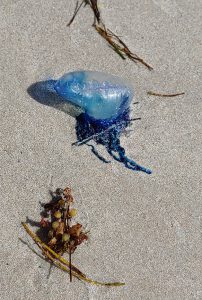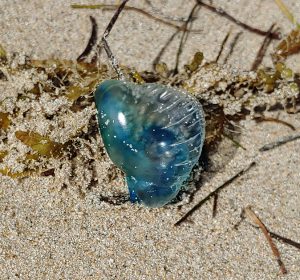When I was young, my mom told me a tale about when she babysat for my cousin before I was born. My mom and cousin Stephanie were on Miami Beach, and all of a sudden, she heard Stephanie screaming. She ran to Stephanie’s side, and my cousin, only four or five years old at the time, had tentacles and angry red welts on her back and arms. My cousin had had an encounter with a Portuguese Man-of-War (Physalia physalis) and fortunately recovered with no problem. This story has stayed with me ever since.
While many are familiar with the Man-of-War, the similar-appearing species By-the-Wind Sailor (Velella velella) can also make appearances on our beaches. Since they look so much like the Man-of-War, it’s important to have a basic understanding of these organisms and err on the side of caution, and avoid them when possible. I bring this up because just last week, I found several dozen of these visitors along the beach at Bear Cut on Virginia Key. The timing of this was surprising, as usually we don’t see Man-of-War or By-the-Wind Sailors until later into the winter season, around January or February.

The Man-of-War is not an individual but rather a group of organisms working together. Their gas-filled sack or pneumatophore is blue in color, and can grow up to 12 inches long. This is what we see dotting the surface of the water. What’s truly scary is that their tentacles extend under the surface of the water, and can be up to 165’ long! These tentacles are what the animal uses to stun and kill their prey (small fish and other invertebrates). For people, these venomous tentacles can administer a painful sting, even if the Man-of-War is dead.
Related to the Man-of-War, the By-the-Wind Sailor features a sail that is blueish/purple in color. Also called a float, the sail can be up to three to four inches in size, smaller than a mature Man-of-War. A fun fact about the By-the-Wind Sailors is that they are considered “left-handed,” in other words, their sail goes from the upper left to the lower right along their long body axis (Bieri 1959). Their tiny, shorter tentacles are much closer to the main part of their body. Also carnivorous, the By-the-Wind Sailor uses their tentacles to trap their prey. While toxins contained in their stinging cells are not as potent as that of the Man-of-War, it’s still prudent to handle the animals carefully, if at all.

Neither creature can self-propel, so they simply drift with currents or wind movement. This is why during certain times of year or with winter storms, they float onto beaches in great numbers. Both species can begin to lose color once they die, leaving their sail or bladder looking more clear instead of blue. During southeast Florida’s winter months, January and February, it’s common to see these gelatinous-looking visitors washing up on local beaches. If you’re on the beach, keep your eyes peeled for them, just in case. If you’re participating in (brrr) in-water activities, be mindful that these creatures could be on the surface above you as you ascend, and be sure that the coast is clear before jumping in!
References:
Bieri, R. 29159. Dimorphism and size distribution in Velella and Physalia. Nature: 184, p. 1333-1334.
 1
1
